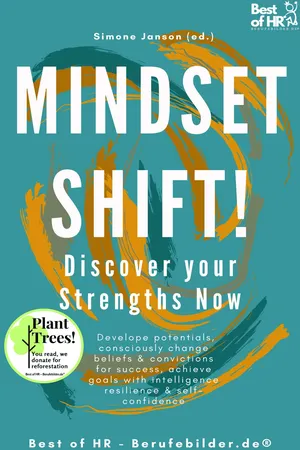
Mindset Shift! Discover your Strengths Now
Develope potentials, consciously change beliefs & convictions for success, achieve goals with intelligence resilience & self-confidence
- English
- ePUB (mobile friendly)
- Available on iOS & Android
Mindset Shift! Discover your Strengths Now
Develope potentials, consciously change beliefs & convictions for success, achieve goals with intelligence resilience & self-confidence
About This Book
With the 5th revised and improved edition, published by a state funded publisher involved in EU programs and a partner of the Federal Ministry of Education, you receive the concentrated expertise of renowned authors (overview in the book preview) and extensive add-ons as well as individual consulting. At the same time, you do good and support sustainable projects. Because people can positively influence their environment with their thinking and behavior and thus lift the undreamed-of potential of their own strengths. An optimistic basic attitude is a decisive advantage here. Who always thinks negatively, does not prepare for crises but only gets used to see things negatively. Too much brooding and thinking not only causes stress and bad moods, but can also lead to anxiety and panic attacks. Here it helps to become aware of one's own success-preventing behavior patterns and deeper-lying beliefs and to change them with a mindset shift. This book shows opportunities and change possibilities as well as self-blockades and helps to overcome the fear of the next step. For its concept "Information as Desired, " the publisher was not only involved in an EU-funded program but also received the Global Business Award as Publisher of the Year. Therefore, by purchasing this book, you are also doing good: The publisher is financially and personally committed to socially relevant projects such as tree planting actions, scholarship foundations, sustainable housing, and many other innovative ideas. The goal of providing you with the best possible content on topics such as career, finance, management, recruiting, or psychology goes far beyond the static nature of traditional books: The interactive book not only provides you with expert knowledge but also allows you to ask individual questions and receive personal advice. In addition, each book contains detailed explanations and application examples to help you make the most of the free consulting services available to book buyers. You can also download e-courses, work with workbooks, or engage with an active community. This way, you receive valuable resources that increase your knowledge, stimulate creativity, make your personal and professional goals achievable, and make successes tangible. And more: We want to give you the opportunity to make your journey to personal growth and success even more unforgettable. Because we know that true change does not only take place in the mind but above all through personal experience and application. That is why we have created special success experiences to complement each book. Expertise and technical innovation go hand in hand, as we take the responsibility of delivering well-founded and well-researched content and the trust you place in us very seriously. Therefore, all texts are written by experts in their field. We only use AI-supported data analysis to better find information that supports your search for knowledge. Publisher and editor Simone Janson is also a bestselling author and one of the 10 most important German bloggers according to the Blogger Relevance Index. She has also been a columnist and author for renowned media such as WELT, Wirtschaftswoche, or ZEIT - more about her can be found on Wikipedia.
Frequently asked questions
Information
Reshaping work processes and changing stuck habits
// By Jake Knapp
When work no longer works
Where do better ideas come from?
How is work optimally divided?
With team workshops to success
The test on the customer
The acid test for new ideas
Table of contents
- Imprint
- Introduction: How this book supports you
- Convenience factor envy: foxes, grapes and other excuses instead of change // By Tom Diesbrock
- Personal change management: 4 steps to change // By Guido Ernst Hannig
- Mindset Shift: Break the power of self-fulfilling prophecy // By Jens Korz
- Rethink work without stress: find meaning, live happily // By Christoph Teege
- Man in business: accompanying change processes // By Marcus König
- Driving innovation and change: a long path to inspiration // By Simone Janson
- Future Mindset in 3 Steps: Digitization - Recognizing and Using Opportunities and Risks // By Sascha Zöller
- Job Search and Lifelong Learning: 10 Application Tips with Growth Mindset // By Simone Janson
- Change management and mindset shift: reduction to the essentials // By Gary Keller & Jay Papasan
- Company in transition: meaningfulness is not an aesthetic philosophy! // By Stefan Dudas
- Develop visions, develop potential, achieve goals: love what you do! // By Simon O. Sinek
- Reshaping work processes and changing stuck habits // By Jake Knapp
- Closing Remarks
- Authors Overview
- About the publisher Best of HR - Berufebilder.de®
- Notes on translation